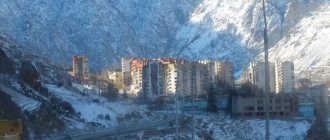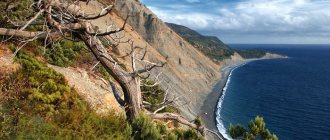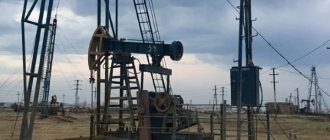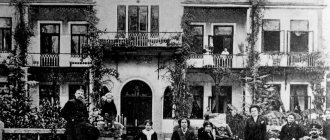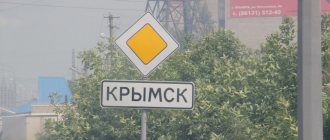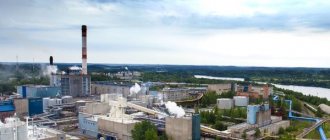The Chegem Gorge is included in the list of the most beautiful places in the Kabardino-Balkarian Republic. It is a huge 15-meter fault in the mountain, about 300 meters high. The Chegem River flows along its bottom. There is a legend that the canyon was formed by the impact of a horse’s hoof when the hero Karashauaya galloped through the Caucasus mountains.
Every year thousands of tourists flock to the Chegem Gorge, wanting to enjoy the beauty of the mountains and waterfalls, feel the local flavor and get a dose of adrenaline while paragliding. The delightful landscapes have repeatedly attracted filmmakers: over the years, scenes from the films “Sannikov’s Land”, “Hero of Our Time” (dir. S. Rostotsky) and “War” (dir. A. Balabanov) were filmed here.
Chegem Gorge: Google panorama
The importance of the city in the modern world
Chegem is located in the central part of the Kabardino-Balkarian Republic, just 3 km from the capital - Nalchik, being, in fact, its suburb. It received its name from the name of the river on the right bank of which it is located.
On the other bank there is a village called “Chegem the Second”, which has an independent status, but is in fact a continuation of “Chegem the First”: they have a common border running along the river, and a common history of education and development. 40 km from Chegem, in the valley of the Chegem Gorge there is the village of “Chegem Nizhny”, and in the mountains, at an altitude of 1.7 km - “Chegem Upper”.
All Chegems are connected among themselves not only by a mountain river formed in the glaciers of the North Caucasus. Geographically, they belong to the Chegem region of the republic and are a tourism and recreation area for residents and guests of Kabardino-Balkaria.
People have settled at the foot of the mountains since very ancient times. Burial sites in the form of burial mounds and archaeological artifacts found in abundance on the Chegem River are confidently attributed by experts to the 14th-16th centuries. The settlement, which became the regional center, appeared a little later.
Its founder is considered to be the former serf Islam Mambetov, who received his freedom from the commander of the Russian troops in the Caucasus, Alexei Petrovich Ermolov, who built many fortresses in these places, including Nalchik. Mambetov continued his service, being an assistant to the Kundetov princes, the owners of this land.
As a sign of encouragement, the princes allocated him a plot of land on the right bank, where Islam built a house for himself and moved his entire family to live. The new village, which appeared in 1822, was named according to local custom after the prince-owner - Kundetov. It became Chegem after the revolution, renamed in 1920 as the bearer of the princely name.
During the Second World War, the village was in the hands of the Nazis for 3 months; it was liberated simultaneously with Nalchik in January 1943. The city honors and remembers the names of the victims. Chegem First became a city only in 2000, its area is 73 km2, and its coordinates are 43°34′00″ N. w. 43°35′00″ E. d.
Day 5. Turist Peak (2450 m)
The way back towards the camp site. Let's take a stroll, there will be an opportunity to take a lot of beautiful photos. We will visit Tourist Peak (2450 m). We spend the night in tents.
Length 7 km
Climate
In the Chegem region, the climate is not the same everywhere; it is determined, first of all, by the terrain and depends on the altitude above sea level. Chegem is a city that is located in the foothill zone and has typical climatic conditions: there are no strong winds, daily fluctuations in air temperature are significant, its average annual value is + 9.5 0C.
Spring comes early and quickly turns into summer; already in mid-April the thermometer can show 30 degrees. Summer is hot and lasts until the end of September; light breezes from the mountains bring relief from the heat. Autumn is long, warm and dry. Winter is mild, almost snowless.
Chegem, weather by month.
Daily air temperature (0C), precipitation (mm), number of sunny days in Chegem:
| Jan. | Feb. | March | Apr. | May | June | July | Aug. | Sep. | Oct. | Nov. | Dec. |
| -3 | +3 | +12 | +14 | +22 | +26 | +28 | +29 | +20 | +11 | +6 | +3 |
| 15 | 9 | 36 | 46 | 111 | 133 | 95 | 70 | 56 | 25 | 20 | 25 |
| 16 | 15 | 15 | 17 | 22 | 22 | 22 | 23 | 21 | 21 | 20 | 20 |
Lower and Upper Chegem are areas of tourist travel. They are distinguished by a mountainous climate, becoming increasingly harsh as they rise in altitude. On the peaks of the Rocky Range there is eternal snow with glaciers.
Paragliding
The mountain parade deserves special attention. The paragliding site is located 17 km from the waterfalls. It is surrounded on all sides by mountains, which creates optimal weather conditions for a comfortable flight. From the end of March to November, in clear weather, dozens of extreme sports enthusiasts flock to the parade ground. For them there is a very comfortable campsite with a kitchen, bathhouse, cafe and other amenities.
Even if you don't want to take off, this place is worth a visit just for the beautiful spectacle. Paragliders soaring at dizzying heights against the backdrop of stunning mountains will remain a pleasant and romantic memory.
© Natalia Semchina
Flora and fauna
The flora and fauna of the surrounding area of Chegem corresponds to the diversity of landscapes. Mountain rivers, descending from glaciers, feed alpine meadows and agricultural lands. The herbs of the meadows are not only decoration, they are pastures for livestock, which are raised here for domestic consumption and export.
The mountain slopes and foothills are the territory of forests, consisting mainly of beech and hornbeam. The unique natural conditions made it possible for plants that can only be found in these places to take root here. The high-mountainous Kabardino-Balkarian Nature Reserve, home to more than 300 species of birds and 60 species of amphibians, is engaged in the protection and conservation of local flora and fauna.
Economy
The city is mainly developed in the sphere of sales and services. Small and medium-sized businesses are developing rapidly. In recent years, the area allocated for growing fruit trees and greenhouse complexes has increased significantly.
The largest enterprises in the city are:
- LLC "Greenhouse complex "Chegem" is one of the largest greenhouse complexes in the North Caucasus.
- Asterra LLC
- LLC "Kamad"
- Chegemvinpischeprom LLC
- Boren LLC
- Karista LLC
How to get there
The main mode of transport in the republic is automobile. The federal highway R-217 “Caucasus” passes through Chegem, connecting the city with all Caucasian and Russian settlements.
Chegem and Nalchik, located 3 km from each other, are connected by 5 public transport routes. Passenger minibuses "Gazelle" ply along them. Their opening hours are from 6-00 to 23-30.
The capital of the republic is a transport hub connecting Kabardino-Balkaria with cities in Russia and abroad. Every day, the Elbrus train departs from Paveletsky Station in Moscow to Nalchik, arriving at the final station after 36 hours. Ticket price – from 3 thousand rubles. (if purchased early).
Along the way, the train makes many stops, including:
- Lipetsk;
- Voronezh;
- Rossoshi;
- Rostov-on-Don;
- Mineral waters.
Electric trains run to the cities of Prokhladny (junction station) and Mineralnye Vody. Nalchik International Airport receives regular flights from Moscow and St. Petersburg, where planes and Pobeda fly. Travel time is 2.5 hours, ticket price is from 2,700 rubles.
Religious buildings of the city and surrounding areas
Mosque of the city of Chegem, located at the address: st. Lenina, 42, is currently under reconstruction. Another one is on the same street, at house 161. Many religious citizens visit Nalchik mosques.
Central Mosque of Kabardino-Balkaria (Nalchik)
The Nalchik Cathedral Mosque is located on Shogentsukov Avenue, 41. Its opening took place in 2004, construction work lasted 4 years. The project by architect A. Asanov was rated as the best in a competition organized by the city authorities. Local materials were widely used in the decoration of the building. The height of the single-dome structure is 21 m, the total area is 1700 m2.
Two tall minaret towers complete the complex.
The building has two floors: the first is square in plan. There are wardrobes, ablution rooms, and separate halls for men and women; in the far corner is the women's prayer hall. The second floor, built in the shape of an octagon, is a prayer hall for men. The presence of two entrances, for parishioners and clergy, also corresponds to the canons of Islam.
Museums
Chegem is a city with one museum. Everyone is willingly invited here to get acquainted with the life and work of the famous fellow villager. Tourists seeking to gain more knowledge about the republic visit Nalchik museums.
Memorial House-Museum of Kaisyn Shuvaevich Kuliev (Chegem)
Every day in Chegem on K. Kuliev Street, 21, except Sunday and Monday, there is a museum of the Balkar poet, who lived in the house where the exhibition is displayed today. He spent the last period of his life here, wrote many works, many of which he dedicated to the Caucasus and its inhabitants. Here the poet died, bequeathing to bury himself near his beloved house.
His grave is located on the territory of the museum. The first half of the exhibition tells in chronological order about the events in the life of K.Sh. Kulieva, the second - demonstrates the furnishings of the last years of his life: office, bedroom, living room, outbuilding. The creation of the exhibition involves the poet’s personal belongings, his books, manuscripts, and photographs.
National Museum of the Kabardino-Balkarian Republic (Nalchik)
The museum, where visitors learn everything about the geographical location, terrain, mining in the republic, as well as its flora and fauna, has been operating since 1921. Much attention is paid here to the history of indigenous peoples, their culture, traditions, and ethnography.
Today, museum workers have a fund of 50 thousand items at their disposal. storage, with the help of which permanent exhibitions and temporary exhibitions are created. Museum address: st. Gorkogo, 62. Ticket price – 50 rubles.
Natural attractions
The Caucasus Mountains themselves are a precious, extraordinarily beautiful and generous attraction. It is not for nothing that many sanatoriums, holiday homes, and sports centers have been built in the mountains and valleys. The Chegem region has unique natural values, which are located in close proximity to the district center.
Chegem River
The Chegem River, which originates in the Bashil glacier, which is located north of Elbrus, and which has given its name to many geographical objects, is worthy of a separate description. It makes its entire 103 km journey to the confluence with the Baksan River through the mountains, winds through a narrow canyon, jumps from a height, and when it reaches the plain, it divides into two streams, which later merge again. And all this at great speed.
Its main natural attractions are the Chegem Canyon and Chegem Waterfalls. However, its largest and most spectacular waterfall is inaccessible to ordinary tourists. It is located in the high mountain zone, where Chegem is called Bashil-Auzusu by the locals. The 78-meter single water jump “Abai-Su” can only be seen by trained climbers.
Chegem Gorge
The winding and deep gorge of Chegem is located 40 km from the city and is the most beautiful and popular tourist attraction in the region. The road to the Chegem Gorge goes past the village of Chegem Vtoroy, other Kabardian settlements, along the river, which has already broken free and flows quickly across the plain.
After the village of Lechinkai the highway begins to cut into a still wide passage formed by mountains growing in height. The village of Nizhny Chegem remains on the right bank. The road continues to go along the bottom of the canyon for some time, while the rocks rise higher and higher. Now they are already hanging over travelers at a height of 300 meters, getting closer to 15-20 m.
The river, compressed on both sides, resisting the onslaught of stones, rushes with a roar from side to side, bending around the obstacles created. This is the 3-kilometer Chegem Gorge, a narrow gap cut by a river in the Rocky Range mountain range. Local legends claim that the mountain parted not under the influence of a stream of water, but from the blow of the hooves of the horse of a mountain hero.
The mountain slopes, where the sun can reach, are covered with greenery: beech and hornbeam forests interspersed with wild fruit trees, berry bushes of barberry, dogwood, and sea buckthorn.
The sun's rays reach the bottom of the gorge for about 3 hours a day, and it is gloomy and bare here. The cliffs with lonely pine trees clinging to the eaves and the roaring river make a strong impression. Filmmakers often choose the picturesque Chegem Gorge as a platform for their work. “Sannikov Land”, “Hero of Our Time”, “War” and others were filmed here.
Chegem waterfalls
Chegem waterfalls are 3 groups of falls that form the Chegem and its tributaries. The picture resembles a fantastic, branched tree. The first of them is “Adai-Su” (“Maiden’s Spit”), which is located not on the Chegem itself, but on a tributary.
To see it, you need to move 150 meters away from the main road. Nature has created a 30-meter stone trench along which water “rolls down.” This is a Small waterfall, but it is the strongest.
The second fall is a whole group called Big Waterfalls:
- “Sakal-Tup” is located on the right tributary of the Chegem, it also “rolls” along a natural gutter.
- The main waterfall is where the next tributary flows into the Chegem. Part of the stream “jumps” in a cascade from a height of 50-60 m, and part of it oozes along the walls, rolling down, sometimes in streams, sometimes as a continuous curtain into the main river. When struck by stones, the streams break into chaotically scattered splashes and water dust. This waterfall always shimmers with all the rainbow colors in sunny weather.
In winter, the waterfalls do not freeze; excursions are organized here all year round.
Excerpt characterizing Chegem Second
Long live this brave king! etc. (French song)] sang Morel, winking his eye. Se diable a quatre... - Vivarika! Vif seruvaru! sit-down... - the soldier repeated, waving his hand and really catching the tune. - Look, clever! Go go go go!.. - rough, joyful laughter rose from different sides. Morel, wincing, laughed too. - Well, go ahead, go ahead! Qui eut le triple talent, De boire, de battre, Et d'etre un vert galant... [Having triple talent, drinking, fighting and being an amiable...] - But it’s also neat. Well, well, Zaletaev!.. “Kyu...” Zaletaev said with effort. “Kyu yu yu...” he drawled, carefully protruding his lips, “letriptala, de bu de ba and detravagala,” he sang. - Hey, it’s important! That's it, guardian! oh... go go go! - Well, do you want to eat more? - Give him some porridge; After all, it won’t be long before he gets enough of hunger. Again they gave him porridge; and Morel, chuckling, began to work on the third pot. Joyful smiles were on all the faces of the young soldiers looking at Morel. The old soldiers, who considered it indecent to engage in such trifles, lay on the other side of the fire, but occasionally, raising themselves on their elbows, they looked at Morel with a smile. “People too,” said one of them, dodging into his overcoat. - And wormwood grows on its root. - Ooh! Lord, Lord! How stellar, passion! Towards the frost... - And everything fell silent. The stars, as if knowing that now no one would see them, played out in the black sky. Now flaring up, now extinguishing, now shuddering, they busily whispered among themselves about something joyful, but mysterious. X The French troops gradually melted away in a mathematically correct progression. And that crossing of the Berezina, about which so much has been written, was only one of the intermediate stages in the destruction of the French army, and not at all a decisive episode of the campaign. If so much has been and is being written about the Berezina, then on the part of the French this happened only because on the broken Berezina Bridge, the disasters that the French army had previously suffered evenly here suddenly grouped together at one moment and into one tragic spectacle that remained in everyone’s memory. On the Russian side, they talked and wrote so much about the Berezina only because, far from the theater of war, in St. Petersburg, a plan was drawn up (by Pfuel) to capture Napoleon in a strategic trap on the Berezina River. Everyone was convinced that everything would actually happen exactly as planned, and therefore insisted that it was the Berezina crossing that destroyed the French. In essence, the results of the Berezinsky crossing were much less disastrous for the French in terms of the loss of guns and prisoners than Krasnoye, as the numbers show. The only significance of the Berezina crossing is that this crossing obviously and undoubtedly proved the falsity of all plans for cutting off and the justice of the only possible course of action demanded by both Kutuzov and all the troops (mass) - only following the enemy. The crowd of Frenchmen fled with an ever-increasing force of speed, with all their energy directed towards achieving their goal. She ran like a wounded animal, and she could not get in the way. This was proven not so much by the construction of the crossing as by the traffic on the bridges. When the bridges were broken, unarmed soldiers, Moscow residents, women and children who were in the French convoy - all, under the influence of the force of inertia, did not give up, but ran forward into the boats, into the frozen water. This aspiration was reasonable. The situation of both those fleeing and those pursuing was equally bad. Remaining with his own, each in distress hoped for the help of a comrade, for a certain place he occupied among his own. Having given himself over to the Russians, he was in the same position of distress, but he was on a lower level in terms of satisfying the needs of life. The French did not need to have correct information that half of the prisoners, with whom they did not know what to do, despite all the Russians’ desire to save them, died from cold and hunger; they felt that it could not be otherwise. The most compassionate Russian commanders and hunters of the French, the French in Russian service could not do anything for the prisoners. The French were destroyed by the disaster in which the Russian army was located. It was impossible to take away bread and clothing from hungry, necessary soldiers in order to give it to the French who were not harmful, not hated, not guilty, but simply unnecessary. Some did; but this was only an exception. Behind was certain death; there was hope ahead. The ships were burned; there was no other salvation but a collective flight, and all the forces of the French were directed towards this collective flight. The further the French fled, the more pitiful their remnants were, especially after the Berezina, on which, as a result of the St. Petersburg plan, special hopes were pinned, the more the passions of the Russian commanders flared up, blaming each other and especially Kutuzov. Believing that the failure of the Berezinsky Petersburg plan would be attributed to him, dissatisfaction with him, contempt for him and ridicule of him were expressed more and more strongly. Teasing and contempt, of course, were expressed in a respectful form, in a form in which Kutuzov could not even ask what and for what he was accused. They didn't talk to him seriously; reporting to him and asking his permission, they pretended to perform a sad ritual, and behind his back they winked and tried to deceive him at every step. All these people, precisely because they could not understand him, recognized that there was no point in talking to the old man; that he would never understand the full depth of their plans; that he would answer with his phrases (it seemed to them that these were just phrases) about the golden bridge, that you cannot come abroad with a crowd of vagabonds, etc. They had already heard all this from him. And everything he said: for example, that we had to wait for food, that people were without boots, it was all so simple, and everything they offered was so complex and clever that it was obvious to them that he was stupid and old, but they were not powerful, brilliant commanders. Especially after the joining of the armies of the brilliant admiral and the hero of St. Petersburg, Wittgenstein, this mood and staff gossip reached its highest limits. Kutuzov saw this and, sighing, just shrugged his shoulders. Only once, after the Berezina, he became angry and wrote the following letter to Bennigsen, who reported separately to the sovereign: “Due to your painful attacks, please, Your Excellency, upon receipt of this, go to Kaluga, where you await further orders and appointments from his imperial Majesty." But after Bennigsen was sent away, Grand Duke Konstantin Pavlovich came to the army, making the beginning of the campaign and being removed from the army by Kutuzov. Now the Grand Duke, having arrived at the army, informed Kutuzov about the displeasure of the sovereign emperor for the weak successes of our troops and for the slowness of movement. The Emperor himself intended to arrive at the army the other day. An old man, as experienced in court affairs as in military matters, that Kutuzov, who in August of the same year was chosen commander-in-chief against the will of the sovereign, the one who removed the heir and the Grand Duke from the army, the one who, with his power, in opposition the will of the sovereign, ordered the abandonment of Moscow, this Kutuzov now immediately realized that his time was over, that his role had been played and that he no longer had this imaginary power. And he understood this not just from court relationships. On the one hand, he saw that military affairs, the one in which he played his role, was over, and he felt that his calling had been fulfilled. On the other hand, at the same time he began to feel physical fatigue in his old body and the need for physical rest. On November 29, Kutuzov entered Vilna - his good Vilna, as he said. Kutuzov was governor of Vilna twice during his service. In the rich, surviving Vilna, in addition to the comforts of life that he had been deprived of for so long, Kutuzov found old friends and memories. And he, suddenly turning away from all military and state concerns, plunged into a smooth, familiar life as much as he was given peace by the passions seething around him, as if everything that was happening now and was about to happen in the historical world did not concern him at all. Chichagov, one of the most passionate cutters and overturners, Chichagov, who first wanted to make a diversion to Greece, and then to Warsaw, but did not want to go where he was ordered, Chichagov, known for his courage in speaking to the sovereign, Chichagov, who considered Kutuzov benefited himself, because when he was sent in the 11th year to conclude peace with Turkey in addition to Kutuzov, he, making sure that peace had already been concluded, admitted to the sovereign that the merit of concluding peace belonged to Kutuzov; This Chichagov was the first to meet Kutuzov in Vilna at the castle where Kutuzov was supposed to stay. Chichagov in a naval uniform, with a dirk, holding his cap under his arm, gave Kutuzov his drill report and the keys to the city. That contemptuously respectful attitude of the youth towards the old man who had lost his mind was expressed to the highest degree in the entire address of Chichagov, who already knew the charges brought against Kutuzov.
Monuments
Chegem is a city that actively participates in the life of the republic and the country. Those who fell during the Second World War while defending the Fatherland are given special honors here. There are modest monuments, marble plaques or memorials in every village.
Monument-memorial to fallen soldiers (Chegem)
On Sovetskaya Street, in a small well-kept square located in the city center, a memorial was erected in honor of the soldiers who died in the fight against the fascist invaders. The complex includes a tall snow-white stele with a star at the top and a sculptural composition consisting of two figures. On both sides of the stele are victorious soldiers. But their poses express bitterness and sorrow for their fallen comrades.
One warrior lowered his bare head low, and the second took a knee, saying goodbye to his fallen colleagues. The sculptural group is located on a raised platform, with three steps leading to the upper platform. In front of the composition is a bowl of eternal fire.
Bas-relief of Vladimir Ilyich Lenin (Chegem)
The monument was erected in the 60s of the last century on the street. Baksan highway, opposite the city administration building. On the front side of a 3-meter white stone block is carved the head of the leader of the world proletariat V.I. Lenin. He knits his eyebrows and looks sternly into the distance.
The remaining edges of the stone remained natural, untreated. Being on an embankment, the work looks even more powerful. The monument is recognized as a work of monumental art of the Soviet era in the postmodern style.
Streets
Alakaev Streets
| Aloeva |
| Ahokhova |
| Beslaneevs |
| Bogotova |
| Pasture |
| Gagarin |
| Kadykoeva |
| Kankosheva |
| Kisheva |
| Komsomolskaya |
| Red |
| Lashina |
| Lenin |
| Tray |
| Oktyabrskaya |
| Pionerskaya |
| River |
| Soviet |
| Circassian |
| School |
| Elbrus |
Dyshekova Lanes
| Kumykova |
| Pervomaisky |
| Tekusheva |
Baksan highway
Excursions
Travel companies in Nalchik offer excursion trips to the most picturesque places of Kabardino-Balkaria.
| Tour operator, contacts | The name of the program | Description | Cost, rub. |
| Tourist st. Keshokova, 102, office 7 7 | "Weekend in Chegem" | Visit to the Chegem Gorge with an overnight stay by the fire. The program includes: acquaintance with the gorge, the river and its tributaries, the ancient Settlement with crypts, and the ruins of temples. | 1500 |
| "Blue Lakes" | Visit to the Chegem Gorge and the karst Blue Lakes - the deepest in the North Caucasus with a water temperature of 9.6 degrees all year round. | 750 | |
| "Towers of Balkaria" | A trip to the Blue Lakes, to the Cherek Gorge, to the village of Upper Balkatia with its ancient sights. | 1300 |
Notes
- ↑ 12
www.gks.ru/free_doc/doc_2016/bul_dr/mun_obr2016.rar Population of the Russian Federation by municipalities as of January 1, 2021 Etoko • Zalukokoazhe • Psynadakha • Malka • Kuba-Taba • Islamey • Baksan • Dugulubgey • Chegem Second • Chegem • Nalchik • Urvan • Old Cherek • Argudan • Anzorey • Khatuey
Route for exploring the city on your own in 1 day
Chegem can be seen in 1 hour. This time is quite enough to get acquainted with the few sights of the city. Next, if you have your own vehicle, you need to go to the mountains and explore the natural scenic sites of the region. This will take the rest of the day. There are roadside cafes along the road and in the mountains where you can have a snack.
If there is no transport, then you will have to organize your day something like this:
- go to Nalchik by public transport;
- purchase a ticket for an excursion trip to the mountains (some daily excursions begin in the afternoon);
- walk the streets of Nalchik, its resort and pedestrian zone, buy souvenirs;
- get acquainted with the exhibition of the local history museum;
- have lunch in a city cafe;
- go with a group on a trip to the mountainous region of the Chegem region.
If the trip to the mountains takes place in the morning, then exploring Nalchik is postponed until the evening. But it’s better to book an excursion ticket in advance by phone or via the Internet in order to better know your daily routine.
Hotels
A huge selection of hotels, mini-hotels, guest houses and hostels is available in nearby Nalchik. There is a sufficient choice of housing in the settlements of Chegem Nizhny and Chegem Verkhny, which are the destination of tourist trips. There is 1 hotel in the city of Chegem.
Hotel (Chegem)
At the address: st. Kulieva, 12 you can book a room with breakfast, free internet and parking. The room is equipped with beds; The shared toilet is located in the corridor. The cost of a double room is 1000 rubles.
Hostel "Teplichny" (Nalchik)
The hostel is located between Nalchik and Chegem at the address: st. Gasovaya, 12.
Here guests are offered 4-6-bed rooms with a living area, TV, and work desk. The bathroom is shared, located in the corridor. The cost of a bed is 530 rubles.
Hotel "Nalchik Hall" (Nalchik)
The hotel is located on the outskirts of the city of Nalchik, on the Caucasus highway passing through Chegem. The modern building is located at the address: Idarova St., 150/1, which is 2 km from the airport. The restaurant offers dishes of national and European cuisine, bar services. The rooms are equipped with furniture and household appliances, ensuring a comfortable stay at the hotel. Room price – from 4500 rub.
Population
| Population | ||||||
| 2002[2] | 2009[3] | 2010[4] | 2012[5] | 2013[6] | 2014[7] | 2015[8] |
| 10 632 | ↗10 648 | ↗10 769 | ↗10 934 | ↗11 075 | ↗11 237 | ↗11 338 |
| 2016[1] | ||||||
| ↗11 374 | ||||||
Density - 162.49 people/km2.
National composition
According to the 2010 All-Russian Population Census[9]:
| People | Number of people, people | Share of the total population, % |
| Kabardians (Circassians) | 9 963 | 92,5 % |
| Balkars | 483 | 4,5 % |
| Persians | 108 | 1,0 % |
| other | 215 | 2,0 % |
| Total | 10 769 | 100 % |
What to bring as a souvenir
Of course, both in Chegem and Nalchik there are many souvenir shops that sell traditional magnets, ceramics, and postcards. But from Kabardino-Balkaria, in addition to impressions, I want to bring something national, interesting and “homely”.
For such goods, you need to go to the market, where grandmothers sell handicrafts made from local wool, men sell meat and nuts, and beauties sell honey and jam. Interesting purchases can be made in the resort area of Dolinsk. Crafts with local flavor are brought here especially for vacationers in sanatoriums.
Woolen knitted and felted items
Shawls, stoles, sweaters, capes, socks, scarves and mittens of various sizes, patterns and colors are sold in Nalchik at the Goat Market (Kanukoeva St.). If the cost of a handmade scarf is 3-5 thousand rubles. will be embarrassing, then you can buy it for 500 rubles. a product made from local wool, but factory knitted.
Sheepskin slippers are a great gift for adults and children; They are soft, warm and very cozy in these parts. The cost for an adult is 400 rubles, for children – from 200 rubles.
Decorations
Metal jewelry is the calling card of Caucasian craftsmen. They do not exist without additional processing: either filigree carving or inlay with stones. Forged metal belts and bibs - elements of the national dress of Kabardian women or traditional gold embroidery will decorate any costume. The costs of a factory-made product and a handmade one also vary greatly.
Weapon
These things need to be looked at in good, specialized stores. Mostly Dagestan daggers are offered here, but local gunsmiths also offer their work for sale.
The products of blacksmiths and minters are not cheap, but the quality and beauty of knives and daggers are worth it. To avoid problems at the airport, do not take bladed weapons in your hand luggage on board the plane. Also, keep receipts and certificates just in case.
Sati doll
A native of these places, the famous singer Sati Casanova became a “beautiful souvenir” in her homeland. This is how fellow countrymen express their love for the girl.
The doll, which looks very similar to Sati, is beautiful in an exact copy of the festive national costume of the Kabardian woman. Such a souvenir will please both an adult and a small woman.
Food
The cuisine of the Caucasus is well known and has long been appreciated. Dairy, meat and sweet products are loved in every region of the country.
From a trip to the Caucasus, you should definitely bring delicious locally produced products to your loved ones:
- cognac;
- cheeses;
- Khychin (pies with different fillings);
- dried lamb;
- honey from local meadows;
- jam (especially from dogwood or walnuts);
- halva, the assortment of which is hard to imagine (with nuts, raisins, candied fruits, chocolate);
- tea collection from local herbs;
- sweets from the Nalchik-sladost factory based on halva, nougat, and fruit.
Chegem is a quiet and peaceful town, whose residents are mainly engaged in agriculture and gardening. Very close to it are the capital of Kabardino-Balkaria, a city with a developed tourist infrastructure, and picturesque mountains with such wonders as rocky gorges, waterfalls, and ancient ruins. This combination is very attractive for a trip to Chegem.

